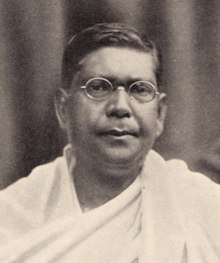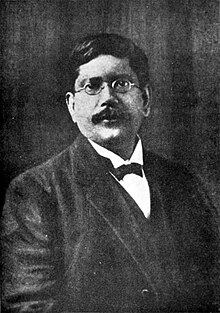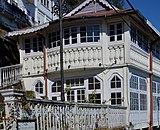| This article needs additional citations for verification. Please help improve this article by adding citations to reliable sources. Unsourced material may be challenged and removed. Find sources: "Chittaranjan Das" – news · newspapers · books · scholar · JSTOR (July 2020) (Learn how and when to remove this message) |
| Chittaranjan Das | |
|---|---|
 | |
| Born | (1870-11-05)5 November 1870 Tongibari, Bengal, British India |
| Died | 16 June 1925(1925-06-16) (aged 54) Darjeeling, Bengal, British India |
| Other names | Deshbandhu |
| Alma mater | Middle Temple |
| Occupation(s) | Freedom fighter, politician, lawyer, educationist, author, poet |
| Political party |
|
| Movement | Anushilan Samiti Indian Independence movement |
| Spouse | Basanti Devi |
| Children | 3 |
Chittaranjan Das (5 November 1870 – 16 June 1925), popularly called Deshbandhu (friend of the country), was a Bengali freedom fighter, political activist and lawyer during the Indian Independence Movement and the political guru of Indian freedom fighter Netaji Subhas Chandra Bose. He was the founder-leader of the Swaraj Party in undivided Bengal during the period of British Colonial rule in India. His name is abbreviated as C. R. Das. He was closely associated with a number of literary societies and wrote poems, apart from numerous articles and essays.
Early life
Chittaranjan Das was born on 5 November 1870 to a well-known Bengali Hindu Baidya Brahmin family in the village named Telirbagh, situated in present-day Tongibari Upazila of the Munshiganj (Bikrampur) district of Bangladesh.
Family
Das family were members of Brahmo Samaj. Chittaranjan was the son of Bhuban Mohan Das, and nephew of the Brahmo social reformer Durga Mohan Das. His father was a solicitor and a journalist who edited the English church weekly, The Brahmo Public Opinion. Some of his cousins were Atul Prasad Sen, Satya Ranjan Das, Satish Ranjan Das, Sudhi Ranjan Das, Sarala Roy and Lady Abala Bose. His eldest grandson was Siddhartha Shankar Ray and his grand daughter is Justice Manjula Bose.
He married Basanti Devi (1880–1974) and had three children, Aparna Devi (1898–1972), Chiraranjan Das (1899–1928) and Kalyani Devi (1902–1983).
Education

The Das family of Durga Mohan was a family of lawyers. Durga Mohan's eldest son Satya Ranjan matriculated at Emmanuel College, Cambridge and was at Middle Temple during 1883–1886, followed by Chitta Ranjan Das, Durga Mohan's brother's son, during 1890–1894. Satish Ranjan Das (1891–1894), Jyotish Ranjan Das and Atul Prasad Sen (1892–1895) followed suit.
In London, Das befriended Sri Aurobindo Ghosh, Atul Prasad Sen, and Sarojini Naidu, among others, and together they promoted Dadabhai Naoroji in the British Parliament.
Career
Law career


In 1894 Das gave up his law practice, and went into politics during the non-cooperation movement against the British colonial government. He again took up the brief, and successfully defended Aurobindo Ghosh on charges of involvement in the Alipore bomb case, in 1909. In his Uttarpara speech, Sri Aurobindo acknowledged that Das broke his health to save him.
In the Alipore bomb case in 1908, Chittaranjan Das as defence counsel for Sri Aurobindo Ghosh, made this closing statement:
My appeal to you therefore is that a man like this who is being charged with the offences imputed to him stands not only before the bar in this Court but stands before the bar of the High Court of History and my appeal to you is this: That long after this controversy is hushed in silence, long after this turmoil, this agitation ceases, long after he is dead and gone, he will be looked upon as the poet of patriotism, as the prophet of nationalism and the lover of humanity. Long after he is dead and gone, his words will be echoed and re-echoed not only in India, but across distant seas and lands. Therefore I say that the man in his position is not only standing before the bar of this Court but before the bar of the High Court of History. The time has come for you, sir, to consider your judgment and for you, gentlemen, to consider your verdict.
Political career
Chittaranjan Das was actively involved in the activities of Anushilan Samiti. When Pramatha Mitter organised the Samiti as its president to produce hundreds of young firebrands who were ready to sacrifice their lives for the cause of the Nation, Chittaranjan became his associate. Anushilan Samiti was maintained by P. Mitter with the assistance of Chittaranjan Das (1894), Haridas Bose (1895), Suren Haldar (1900) and Manabendra Nath Roy (1901).
He was a leading figure in Bengal during the Non-Cooperation Movement of 1919–1922, and initiated the ban on British-made clothes, setting an example by burning his own European clothes and wearing Khadi clothes. He brought out a newspaper called Forward and later changed its name to Liberty as part of his support for various anti-British movements in India. When the Calcutta Municipal Corporation was formed, he became its first mayor.
He was a believer in non-violence and constitutional methods for the realisation of national independence, and advocated Hindu-Muslim unity, cooperation and communal harmony and championed the cause of national education. He resigned his presidency of the Indian National Congress at the Gaya session after losing a motion on "No Council Entry" to Gandhi's faction. He then founded the Congress-Khilafat Swaraj Party, with Narasimha Chintaman Kelkar and veteran Motilal Nehru. Other prominent leaders included Huseyn Shaheed Suhrawardy and Subhas Chandra Bose of Bengal, Vithalbhai Patel and other Congress leaders who were becoming dissatisfied with the Congress. In May 1923, at AICC meet in Bombay, Das was able to get majority support for his policy of council entry, with 96 members voting in favour, and 71 against.
Poet
Chittaranjan Das emerged as a distinguished Bengali poet, when, during the troubled days of National movement, he published the first two volumes of his collection of poems titled "Malancha" and "Mala". In 1913 he published "Sagar Sangeet" (The Songs of the Sea). Sri Aurobindo was in Pondichery and when he was in dire need of financial support. Chittaranjan offered him one thousand rupees as a token of his support for an English translation of the poem, a few verses of which are given below:
Songs of the Sea
I
O thou unhoped-for elusive wonder of the skies,
Stand still one moment! I will lead thee and bind
With music to the chambers of my mind.
Behold how calm today this sea before me lies
And quivering with what tremulous heart of dreams
In the pale glimmer of the faint moonbeams.
If thou at last art come indeed, O mystery, stay
Woven by song into my heart-beats from this day.
Stand, goddess, yet! Into this anthem of the seas
With the pure strain of my full voiceless heart
Some rhythm of the rhythmless, some part
Of thee I would weave today, with living harmonies
Peopling the solitude I am within.
Wilt thou not here abide on that vast scene,
Thou whose vague raiment edged with dream haunts us and flees,
Fulfilled in an eternal quiet like this sea’s?
II
I lean to thee a listening ear
And thy immense refrain I hear,
O Ocean circled with the lights of morn.
What word is it thou sing’st? what tune
My heart is filled with, and it soon
Must overflow? What mystical unborn
Spirit is singing in thy white foam-caves?
What voice turns heaven to music from thy waves?
III
Long gazing on this dawn and restless sea,
My heart is moved with a strange minstrelsy.
Tranquil and full and slow that music’s sound
Or a chant pitiful, tender and profound.
At times its passing fills my heart with tears.
Maddened it runs and maddening him who hears.
What spirit lives and laughs and weeps in thee?
What thought is here that cries eternally?
I know not, but a trembling sweet and strong
Has taken my every limb touched by thy song,
O infinite Voice, O Soul that callst to me,
As I look on this luminous dawn and on the sea!
...
Chittaranjan started a monthly journal named Narayana, and many eminent writers such as Sharat Chandra Chattopadhyay, Bipin Chandra Pal and Hariprasad Shastri contributed their writings in the journal.
Death
-
 Chittaranjan Das with cane in hand, and Mahatma Gandhi on the Hill Cart Road near Kakjhora, Darjeeling in 1925
Chittaranjan Das with cane in hand, and Mahatma Gandhi on the Hill Cart Road near Kakjhora, Darjeeling in 1925
-
 Residence of Chittaranjan Das in Darjeeling West Bengal
Residence of Chittaranjan Das in Darjeeling West Bengal
-
Chittaranjan's funeral procession in 1925
In 1925 Chittaranjan's health began to fail due to overwork. Chittaranjan went to Darjeeling to recuperate his health staying at Sir N. N. Sircar's house "Step Aside" in May 1925. Mahatma Gandhi visited him and stayed with him for some days. Gandhiji wrote,
When I left Darjeeling I left much more that I had ever thought before. There was no end of my affection for Deshbandhu and my warm feeling for such a great soul.
The funeral procession in Calcutta was led by Gandhi, who said:
Deshbandhu was one of the greatest of men... He dreamed... and talked of freedom of India and of nothing else... His heart knew no difference between Hindus and Muslims and I should like to tell Englishmen, too, that he bore no ill-will to them.
Legacy

- Chittaranjan National Cancer Institute of Kolkata had its humble beginning in the year 1950 when the Chittaranjan Cancer Hospital was founded in the premises of Chittaranjan Seva Sadan. A few years before his death Chittaranjan gifted this property including his house and the adjoining lands to the nation to be used for the betterment of the lives of women.
- Chittaranjan Avenue, the main thoroughfare of Kolkata connecting North Kolkata with Central Kolkata, it was formerly known as Central Avenue.
- Chittaranjan, a town located in the Paschim Bardhaman district near Asansol. It is located at the border of Bengal and Jharkhand. It is famous for housing the legendary Chittaranjan Locomotive Works.
- Chittaranjan Locomotive Works, the largest locomotive manufacturing unit in the whole world.
- Chittaranjan College, a bachelor arts and science government college located in the historic College Street district of North Kolkata.
- Chittaranjan Park, home to large Bengali community, originally EPDP Colony in South Delhi was named after Deshbandhu Chittaranjan Das during 1980's
- Deshbandhu College for Girls, a women's college on Rashbehari Avenue in South Kolkata, established in 1955 and affiliated to University of Calcutta, is named honouring his legacy.
References
- ^ "Das, Chittaranjan". Oxford Dictionary of National Biography (online ed.). Oxford University Press. (Subscription or UK public library membership required.)
- ^ Chitta Ranjan Das at the Encyclopædia Britannica
- "'Deshbandhu' Chittaranjan Das, freedom fighter who became a lawyer after failing ICS exam". ThePrint. Archived from the original on 30 July 2020. Retrieved 19 June 2021.
- "Deshbandhu Chittaranjan Das". ThePrint. 19 June 2021. Archived from the original on 30 July 2020.
- Saraf, Nandini (1 January 2013). The Life And Times Of Deshbandhu Chittranjan Das. Prabhat Prakashan. p. 20. ISBN 978-81-8430-213-4. Archived from the original on 5 July 2023. Retrieved 27 July 2022.
- ^ Sen, Rathindra Nath (1989), Life and times of Deshbandhu Chittaranjan Das, Northern Book Centre, ISBN 978-81-8511-955-7
- Sturgess, H.A.C., ed. (1949), Register of Admissions to the Honourable Society of the Middle Temple. From the Fifteenth Century to the Year 1944 – Volume II (1782–1909), London: published for the Hon. Society of the Middle Temple by Butterworth & Co.
- "Middle Temple" (PDF). hosted.law.wisc.edu. Archived (PDF) from the original on 28 July 2018. Retrieved 2 September 2017.
- "Remembering Chittaranjan Das on his 97th death anniversary: Know lesser-known facts about 'Deshbandhu'". The Free Press Journal. Archived from the original on 22 September 2022. Retrieved 22 September 2022.
- Muktiprana, Parivrajika (1960), Bhagini Nividita, p. 298
- Dasgupta, Hemendranath (1994), "Deshbandhu Chittaranjan Das", in Grover, Verinder (ed.), Chittaranjan Das, Deep & Deep Publications, p. 236, ISBN 978-81-7100-568-0
- Mukhopadhyay, Haridas; Mukhopadhyay, Uma (1960), Swadeshi Andolan O Banglar Nayayug, p. 155
- Dutt, Bhupendra Nath (23 December 1960), "Viplabee Pramatha Nath", Biplabee Bangali
- "Remembering Chittaranjan Das: 10 inspirational facts about 'Deshbandhu'". India Today. Archived from the original on 23 September 2022. Retrieved 23 September 2022.
- ^ Guha, Ramchandra (2018). Gandhi: The Years That Changed the World. Penguin Allen Lane. p. 202. ISBN 978-0670083886.
- Saraf, Nandini (2013), The Life and times of Deshbandhu Chittaranjan Das, Delhi: Ocean Books Pvt Ltd, ISBN 978-81-8430-213-4
- ""Deshbandhu" Chittaranjan Das… Saluting Kolkata's Premier 'First Citizen'". Kolkata Municipal Corporation.
- Kripalani, Sucheta (1994), "C.R. Das: Tribute to the Memory of a Great Patriot", in Grover, Verinder (ed.), Chittaranjan Das: Political Thinkers of Modern India, Deep & Deep Publications, p. 294, ISBN 978-81-7100-568-0
- Gandhi, M. K. (1924), Collected Works of Mahatma Gandhi, vol. 27, New Delhi: Publications Division Government of India, p. 250, archived from the original on 12 October 2017, retrieved 27 September 2017
- "Who we are". Chittaranjan National Cancer Institute. Archived from the original on 29 September 2017. Retrieved 27 November 2011.
External links
- Chitta Ranjan Das at Banglapedia
- Works by or about Chittaranjan Das at the Internet Archive
- Works by Chittaranjan Das at Project Gutenberg
- Works by Chittaranjan Das at Open Library
- Newspaper clippings about Chittaranjan Das in the 20th Century Press Archives of the ZBW
| Indian independence movement | |
|---|---|
| History |
|
| Philosophies and ideologies | |
| Events and movements |
|
| Organisations |
|
| Social reformers |
|
| Independence activists |
|
| British leaders | |
| Independence | |
| Das family | |
|---|---|
| 1st generation | |
| 2nd generation | |
| 3rd generation | |
| 4th generation | |
| Related families | |
- 1869 births
- 1925 deaths
- Brahmos
- Bengali Hindus
- People from Munshiganj District
- Das family of Telirbagh
- Anti-British establishment revolutionaries from East Bengal
- Indian barristers
- Indian independence activists from Bengal
- Politicians from Kolkata
- Presidents of the Indian National Congress
- People from Bikrampur
- Mayors of Kolkata
- 19th-century Indian lawyers
- 20th-century Indian lawyers